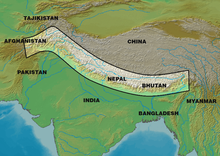User:Kwojtas2/sandbox
| Indian Belladonna | |
|---|---|
| Scientific classification | |
| Kingdom: | |
| Division: | |
| Class: | |
| Order: | |
| Family: | |
| Genus: | |
| Species: | A. acuminata
|
| Binomial name | |
| Atropa acuminata | |
The Indian Belladonna,Atropa acuminata, is one of the four species of the Atropa genus within the Mediterranean region. It is an herb within the nightshade family and is similar to the European Atropa belladonna.[1]
Distribution[edit]
Atropa acuminata naturaly occurs within India at a mean sea level(Msl) of 2500-3000.[2] This means that it mainly grows in mountainous areas within India. Large quantities of the Indian Belladonna grow on the Himalaya mountain range at an altitude of 6,000-12,000 ft. above sea level. Growth occurs in the Kashmir, Kunawar, Barmula, Kinnaur, Simla, and Nainital districts in India.[3] [4]

Habitat and Ecology[edit]
“Atropa acuminata” is a perennial herb that grows on porous soil with a fair amount of drainage. The soil usually has some kind of mineral constituents such as potash and lime.[5] The Indian Belladonna requires a fairly warm and hilly area that has some kind of shade that would be obtained with the help of other taller plants. The temperature range which Atropa acuminata is adapted to ranges from 20-30 degrees Celsius.[5]
Morphology[edit]
Individuals of this species are bush-like herbs that are usually tall. The plant is found to be erect and is found to be at a height of 2-5 feet.[6] It is found to have dichotomous branching patterns and the leaves occur with an opposite pattern while they are green and also found to be elliptical all the way to the top from the base.[6] They vary in size ranging from 3-8 inches long and 1.5-2.5 inches wide. [4]
Flowers and fruit[edit]
The axillary, drooping flowers of the Atropa acuminata have a yellowish tint to them.[4] The Indian Belladonna blooms in June-August which produces solitary flowers or flowers in groups of 2 or 4.[4] The fruit tends to be globular and looks like a cherry when it becomes ripe which is around October.[4] It is known that the fruit is one of the most toxic parts of the plant.
Medicinal Uses[edit]
Atropa acuminata is used as an anticholinergic which is a substance that stops the neurotransmitter acetylcholine in the central and the peripheral nervous system. [7] It is also used in western medicine as a sedative, an antispasmodic, for dilation of the pupil of the eye during operations, and even used as an antidote for poisoning caused by opium or muscarine. [4] The Indian Belladonna has also been used to treat the symptoms of Parkinson's disease by increasing mobility and reducing tremors.[8]
Toxicity[edit]
This plant is known to be very toxic just like other plants within the Nightshade family. The whole plant and especially the roots are very toxic to the point that simple handling the plant would have a negative effect upon an individual if they had some kind of cuts. [9] Toxins are also concentrated within the attractive sweet fruit of the Atropa acuminata which makes it quite dangerous for children. [9] The toxicity is due largely to the amount of alkaloids found in it such as hyoscyamine, apoatropine, and scopolamine which are also found in the European Belladonna, Atropa belladonna. [1] These alkaloids actually inhibit the parasympathetic nervous system which controls involuntary body functions. [8] Inhibiting involuntary body functions could lead to a quick death.
References[edit]
- ^ a b Khan, M. (1991). "A comparison of the Effect of Mechanical and Insect Damage on Alkaloid Levels in Atropa acuminata". Biochemical Systematics and Ecology. 19 (7): 529–534. doi:10.1016/0305-1978(91)90092-E.
{{cite journal}}: Unknown parameter|coauthors=ignored (|author=suggested) (help) - ^ Chander, Harish (2005). Ecological studies and conservation of medicinal plants of Neeru Watershed. Baba Saheb Amedkar Road, Jammu, India: Department of Botany, University of Jammu. p. 83.
- ^ The Biology and Taxonomy of the Solanaceae. Academic Press. 1979.
- ^ a b c d e f Chopra (1933). Indigenous drugs of India. Bimal Kumar Dhur of Academic Publishers. p. 73. ISBN 9788185086804. Cite error: The named reference "Flower" was defined multiple times with different content (see the help page).
- ^ a b Chopra (1933). Indigenous drugs of India. Bimal Kumar Dhur of Academic Publishers. p. 75. ISBN 9788185086804.
- ^ a b Chopra (1933). Indigenous drugs of India. Bimal Kumar Dhur of Academic Publishers. p. 72. ISBN 9788185086804.
- ^ Kaul, M K (January 2010). "HIgh altitude botanicals in integrative medicine-Case studies from Northwest Himalaya". Indian Journal of Traditional Knowledge. 9: 18–25.
{{cite journal}}: CS1 maint: date and year (link) - ^ a b Chevallier, Andrew (1996). The Encyclopedia of Medicinal Plants. DK.
- ^ a b Grieve, Maud (1971). A modern herbal. Dover.

